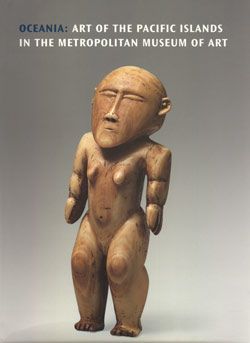Head (Ganabi)
In the past, the art of the Gogodala people centered largely on two major themes, the ornamentation of canoes and the creation of ritual paraphernalia for aida, a complex ceremonial cycle that culminated in male initiation, which honored the supernatural heroes who established Gogodala culture. Among the most engaging
creations of Gogodala artists were small wood heads (ganabi), which were typically attached to larger works such as masks, ceremonial rattles, and canoe prows. This head likely once adorned a ligale, a large oval dance mask worn during the aida rites. The heads on ligale represented primordial totemic ancestors or clan founders, shown with the distinctive conical basketry hats (diba) worn by Gogodala men. Presented at initiation, the diba was permanently affixed to the top of the head and protected the wearer from malevolent spirits, who were believed to enter the body through the hair. Largely abandoned in the 1930s due to the influence of Christian missionaries, many Gogodala art forms were revived in the 1970s and continue today.
This image cannot be enlarged, viewed at full screen, or downloaded.


